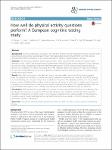How well do physical activity questions perform? A European cognitive testing study
Finger, Jonas
Gisle, L.
Santos-Hövener, Claudia
Kruusmaa, E. K.
Matsi, A.
Oja, L.
Balarajan, M.
Gray, M.
Kratz, Anna Lena
Lange, Cornelia
Background: Only few studies have focused on the cognitive processes of the respondents that are involved when answering physical activity questionnaires (PAQs). This study aimed at examining whether two PAQs work as intended with different segments of the survey population in different cultural settings in Europe. Methods: The International Physical Activity Questionnaire - Short Form (IPAQ-SF) and the US National Health Interview Survey - Adult Core Physical Activity Questionnaire (NHIS-PAQ) were tested in Belgium, Estonia, Germany and the UK using a standardized cognitive interviewing procedure. IPAQ-SF measures total vigorous physical activity (PA), moderate PA, walking and sitting. NHIS-PAQ measures leisure-time vigorous PA, light and moderate PA and muscle-strengthening PA. In total 62 persons completed cognitive interviews, at least 15 interviews were conducted in each country. Results: Both PAQs performed as intended with young and high-skilled persons and those having a regular exercise schedule. For the others, however, the testing revealed that problems occurred with both PAQs relating to understanding the concepts of ‘(light and) moderate’ and ‘vigorous’ PA, classifying activities into the provided answer options of different PA intensities, recalling instances of ‘normal’ activities such as walking and sitting, and calculating the total duration of more than one activity or instance of an activity. The revealed problems with the questionnaires were quite similar in different countries; profound cultural differences were not observed. Conclusions: Both questionnaires were difficult to answer for many respondents and rather user-unfriendly. They are designed to measure an exactness of PA quantity (frequency and duration) and intensity which would be desirable to obtain from a scientific point of view; however, respondents can hardly provide this information for cognitive reasons. Studies investigating the respondents’ perspective are useful for improving physical activity information based on self-reports.
No license information

